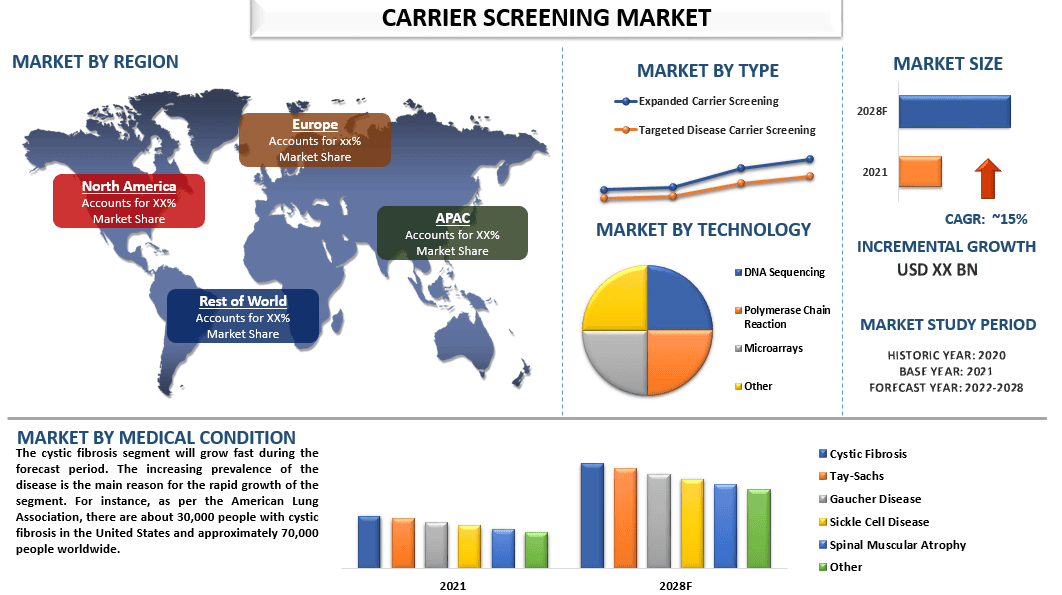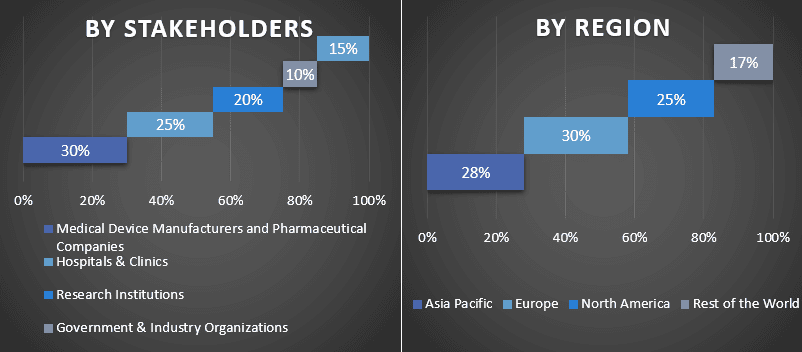
全球帶因者篩檢市場預計在預測期內以約 15% 的顯著速度增長。 基因篩檢是一種用於識別具有較高罹患特定疾病風險或攜帶特定疾病基因的個體的工具。它是一種基因檢測,用於識別個體遺傳物質(例如染色體、基因或蛋白質)的變化。基因疾病本質上是永久性的,或治療費用昂貴,導致對帶因者篩檢測試的需求不斷增加。此外,對研發的投資不斷增加也是促進市場增長的重要因素。例如,根據美國國會研究服務處的數據,自 2000 年以來,全球研發總支出已增加兩倍以上,從 6,750 億美元增加到 2020 年的 2.4 兆美元。
Myriad Genetics, Inc.; Cepheid; Illumina, Inc; Thermo Fisher Scientific; F. Hoffmann-La Roche Ltd; Laboratory Corporation of America Holdings; Otogenetics; T MedGenome; Genentech, Inc; 和 CENTOGENE N.V. 是市場上的一些主要參與者。這些參與者進行了多次併購以及合作夥伴關係,以向客戶提供高科技和創新產品/技術。
報告中提出的見解
“在類型中,擴展型帶因者篩檢類別在預測期內將以最高的複合年增長率增長。”
根據類型,市場分為擴展型帶因者篩檢和目標疾病帶因者篩檢。其中,擴展型帶因者篩檢類別在預測期內將以最高的複合年增長率增長。擴展型帶因者篩檢是指超出一個人的種族和家族史的生殖基因帶因者篩檢。由於該技術能夠一次讀取 100 多個基因並檢查多種基因疾病,因此該細分市場預計在預測期內將實現快速增長。
“在醫療狀況中,囊性纖維化細分市場在預測期內將快速增長”
根據醫療狀況,市場分為囊性纖維化、泰薩克斯病、戈謝病、鐮狀細胞病、脊髓性肌肉萎縮症和其他疾病。其中,囊性纖維化細分市場在預測期內將快速增長。該疾病患病率的增加是該細分市場快速增長的主要原因。例如,根據美國肺臟協會的數據,美國約有 30,000 名囊性纖維化患者,全球約有 70,000 名患者。
“在終端用戶中,診所細分市場在預測期內將保持更高的複合年增長率”
根據終端用戶,市場分為醫院、實驗室、診所和其他機構。其中,診所細分市場在預測期內保持更高的複合年增長率。私人臨床醫生的數量不斷增加,以及政府在開發當地診所以更好地獲得醫療保健設施方面的努力,都促進了帶因者篩檢市場中該細分市場的顯著增長。
“亞太地區將見證市場上最快的增長”
預計亞太地區在預測期內將以最快的速度增長。新興經濟體的存在、頻繁的產品發布以及支持兒童和孕產婦健康的政府政策等主要因素是該地區市場增長的原因。例如,2020 年 8 月,衛生和家庭福利聯盟部長 Harsh Vardhan 博士在印度紅十字會國家總部血庫啟用了地中海貧血篩檢和諮詢中心。
購買本報告的理由:
- 該研究包括經過驗證的授權主要行業專家的市場規模和預測分析。
- 該報告一目了然地快速回顧了整個行業的績效。
- 該報告涵蓋了對傑出行業同行的深入分析,主要側重於主要業務財務、產品組合、擴張策略和最新發展。
- 詳細檢查行業中普遍存在的驅動因素、限制因素、關鍵趨勢和機會。
- 該研究全面涵蓋了跨不同細分市場的市場。
- 對該行業進行深入的區域層面分析。
客製化選項:
全球帶因者篩檢市場可以根據要求或任何其他市場細分市場進一步客製化。此外,UMI 了解您可能有自己的業務需求,因此請隨時與我們聯繫以獲取完全符合您要求的報告。
目錄
載體篩檢市場分析 (2022-2028) 的研究方法
分析歷史市場、估計當前市場以及預測全球載體篩檢市場的未來市場,是創建和分析全球主要地區載體篩檢應用情況的三個主要步驟。我們進行了詳盡的二級研究,以收集歷史市場數據並估計當前市場規模。其次,為了驗證這些見解,我們考慮了許多發現和假設。此外,我們還對全球載體篩檢市場價值鏈中的行業專家進行了詳盡的初級訪談。在通過初級訪談對市場數據進行假設和驗證後,我們採用了自上而下/自下而上的方法來預測完整的市場規模。此後,我們採用市場細分和數據三角測量方法來估計和分析行業相關的細分市場和子細分市場的市場規模。詳細方法如下所述:
歷史市場規模分析
步驟 1:深入研究二級來源:
我們進行了詳細的二級研究,以通過公司內部來源(如年度報告和財務報表、業績演示文稿、新聞稿等)以及外部來源(包括期刊、新聞和文章、政府出版物、競爭對手出版物、行業報告、第三方數據庫和其他可靠出版物)獲取載體篩檢市場的歷史市場規模。
步驟 2:市場細分:
在獲得載體篩檢市場的歷史市場規模後,我們進行了詳細的二級分析,以收集主要地區不同細分市場和子細分市場的歷史市場見解和佔有率。報告中包含的主要細分市場包括類型、醫療狀況、技術和最終用戶。此外,我們還進行了國家/地區層面的分析,以評估該地區檢測模型的總體應用情況。
步驟 3:因素分析:
在獲得不同細分市場和子細分市場的歷史市場規模後,我們進行了詳細的因素分析,以估計載體篩檢市場的當前市場規模。此外,我們使用載體篩檢的類型、醫療狀況、技術和最終用戶等因變量和自變量進行了因素分析。我們對需求和供應側情景進行了徹底的分析,同時考慮了全球載體篩檢市場領域的頂級合作夥伴關係、併購、業務擴張和產品發布。
當前市場規模估計和預測
當前市場規模測算:基於上述 3 個步驟的可行見解,我們得出了當前市場規模、全球載體篩檢市場中的主要參與者以及各細分市場的市場佔有率。所有必需的百分比份額拆分和市場細分均使用上述二級方法確定,並通過初級訪談進行了驗證。
估計和預測:對於市場估計和預測,我們為不同因素分配了權重,包括驅動因素和趨勢、限制以及利益相關者可獲得的機會。在分析了這些因素後,我們應用了相關的預測技術,即自上而下/自下而上的方法,以得出全球主要市場不同細分市場和子細分市場的 2028 年市場預測。用於估計市場規模的研究方法包括:
- 行業的市場規模,以收入(美元)和國內主要市場中載體篩檢市場的應用率來衡量
- 市場細分市場和子細分市場的所有百分比份額、拆分和細分
- 全球載體篩檢市場中,就所提供的產品而言的主要參與者。此外,這些參與者為在快速增長的市場中競爭而採用的增長戰略
市場規模和佔有率驗證
初級研究:我們與主要意見領袖 (KOL) 進行了深入訪談,包括主要地區的最高級管理人員(CXO/VP、銷售主管、市場主管、運營主管、區域主管、國家主管等)。然後總結初級研究結果,並進行統計分析以驗證既定假設。初級研究的輸入與二級研究結果相結合,從而將信息轉化為可行的見解。
不同地區初級參與者的拆分

市場工程
我們採用了數據三角測量技術來完成整體市場估計,並得出全球載體篩檢市場各個細分市場和子細分市場的精確統計數據。在研究了全球載體篩檢市場中類型、醫療狀況、技術和最終用戶的各種參數和趨勢後,數據被拆分為幾個細分市場和子細分市場。
全球載體篩檢市場研究的主要目標
研究中指出了全球載體篩檢市場的當前和未來市場趨勢。投資者可以獲得戰略見解,以便根據研究中執行的定性和定量分析來判斷他們的投資。當前和未來市場趨勢決定了區域層面市場的整體吸引力,從而為行業參與者提供了一個利用未開發市場以從先發優勢中獲益的平台。研究的其他定量目標包括:
- 分析載體篩檢市場當前和預測的市場規模(以價值(美元)計)。此外,分析不同細分市場和子細分市場當前和預測的市場規模
- 研究中的細分市場包括類型、醫療狀況、技術和最終用戶領域。
- 定義和分析載體篩檢行業的監管框架。
- 分析涉及各種中介機構的價值鏈,以及分析行業的客戶和競爭對手行為。
- 分析主要地區載體篩檢市場的當前和預測市場規模。
- 報告中研究的各個地區的主要國家/地區包括亞太地區、歐洲、北美洲和世界其他地區。
- 載體篩檢市場的公司概況以及市場參與者為在快速增長的市場中維持發展而採用的增長戰略
- 深入分析該行業的區域層面
相關 報告
購買此商品的客戶也購買了










